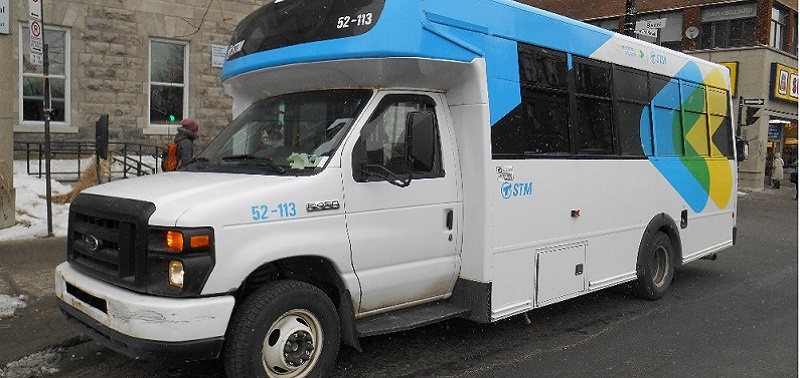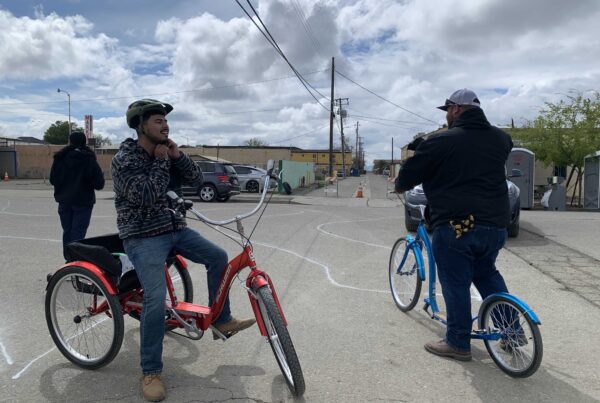Pull up a chair because one of the most expensive, inefficient forms of public transportation is about to be disrupted – and get the boost it needs to work better for both riders and transit agencies.
Paratransit services – which usually take the form of publicly subsidized “door-to-door” trips in wheelchair-accessible shuttles and taxis – play a vital role in serving senior citizens and those whose disabilities prevent them from riding traditional public transit.
Many services use a “dial-a-ride” model that requires riders to schedule their trips through a call center by 5 p.m. the day prior. The American Disability Act (ADA) also requires paratransit operators to provide service within 3/4 mile of fixed-route public transit and pick up passengers within a 2-hour window.
These services are extremely important in helping provide access to transportation. However, they are not a model of efficiency. Especially when compared with the breakthroughs being made in other areas of transportation such as real-time data-enabled mobile apps and dynamic route and new carpooling tools developed by ridesourcing companies like Uber, Lyft and Bridj.
These trends have led transportation professionals to question whether there is an opportunity for a new paratransit model that can better adjust resources to demand and improve performance and efficiency. The topic came up yet again at the recent Live Ride Share conference in Los Angeles, and featured prominently in our afternoon ridesourcing discussion featuring representatives from Uber, Lyft and the Los Angeles Taxicab Commission. Suffice it to say, people are talking.
While a major “smart” paratransit service has yet to emerge, there are many exciting possibilities to consider including using new ridesharing technology to enhance current services; creating totally new service models; and working with Transportation Networking Companies (TNCs) to provide more efficient paratransit services.
Leveraging New Technology
New shared mobility services such as UberPOOL and Lyft Line allow users to share a ride – and split the cost – with others who have requested a ride along a similar route. While the concept of carpooling is not new, these services facilitate ridesharing using the on-demand convenience and reliability that have become the hallmark of ridesourcing providers.
Boston-based “smart” shuttle operator Bridj uses real-time information such as customer location and changes in traffic to create a series of dynamically generated, “pop-up” minibus routes. Each Bridj seats up to 14 passengers and optimizes pick-ups, drop-offs and routing based on demand. Several other providers have also created ridesharing and carpooling apps including Carma, Sidecar and Enterprise’s Zimride. Some companies, such as Canada’s TripSpark, have even taken the first step in applying these new approaches to demand response and paratransit software.
The implications are exciting for paratransit providers, who could use such technology to make service much more convenient, cost-effective and user friendly.
Exploring New Models
Several new companies have also launched in recent years that leverage new technology to serve groups with specific needs, such as the elderly and young children.
San Francisco-based Lift Hero is a ridesharing service that allows the elderly to hail a car driven by specially trained medical professionals. The service, which was started by a med student in search of better transportation options for his grandmother, also provides personalized ride reminders and allows users to view the trip in real-time.
Nonprofit mobility provider ITNAmerica has also blazed a trail in providing transportation for the elderly through the use of volunteer drivers and personal mobility credits, which it bills as “social security for transportation.” Operators such as Shuddle and Boost by Benz, a Mercedes-Benz initiative in Palo Alto, have developed with a focus on providing transportation for young children, but may also have implications for paratransit. Shuddle uses drivers who are licensed childcare professionals, while Boost by Benz takes kids to and from school using vans and an algorithm to economize trips.
These companies are using new business models that are highly relevant to paratransit, and that may help drive improvements for riders.
Working with Existing Providers
Since many local governments already use private companies to provide paratransit service, another option is to incentivize current ridesourcing companies such as Uber, Lyft and Sidecar to expand their offerings to include paratransit services.
There are some indications that these companies would be interested in exploring such an arrangement. For instance, it came to light in January that Uber had approached the City of San Francisco about taking over the city’s paratransit operations. While the negotiations were ultimately not successful, they do raise the issue of ridesourcing companies expanding into paratransit and other niches.
Lyft has stated that it is looking for ways to expand access for disabled riders and make fleets of on-demand paratransit vehicles available for new and existing passengers. Uber has launched several relevant products including UberWAV, which allows riders to request wheelchair-accessible vehicles and provides “on-demand pickups within minutes instead of days.” UberASSIST is designed to provide additional assistance for members of the senior and disability communities. The service uses drivers specifically trained to assist riders into vehicles, which can accommodate folding wheelchairs, walkers and scooters (but do not have wheelchair ramps or lifts).
However, such services are still available only in select markets. Cost is another concern. In San Francisco, UberWAV requires a $25 minimum ride for use and does not accept the city-subsidized debit card. In general, the costs are comparable to Uber’s “Uber Black” limo service – likely not the best fit for seniors living on a fixed income.
The paratransit sector is also often far from profitable, and shrinking government revenues may make incentivizing participation by ridesourcing companies problematic.
Some cities have in fact chosen to use companies such as Uber and Lyft as an additional source of revenue to ensure availability of paratransit vehicles. For instance, Seattle passed an ordinance last summer creating a 10-cent surcharge on every ride originating in Seattle with uberX, Lyft, or Sidecar that will be used to defray the cost of owning and driving a wheelchair-accessible taxi.
These issues will only become more critical as our population continues to age in the coming years. We also believe this issue relates directly to SUMC’s mission to extend the benefits of shared mobility for all, and plan to continue exploring transportation solutions for elderly and disabled riders in the months ahead.
Photo by Jeangagnon




3 Comments